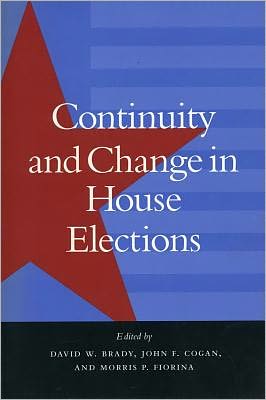Continuity and Change in House Elections
“Given the relatively saturated nature of scholarship on congressional elections, it is indeed a compliment to say that Continuity and Change in House Elections, edited by David W. Brady, John F. Cogan, and Morris P. Fiorina, makes a significant contribution to the literature. It convincingly explains why the Republicans gained the majority in the House in 1994. Moreover, the contributors nicely point the way toward a new approach to House elections that more explicitly incorporates political...
Search in google:
This book analyzes continuity and change in elections to the U.S. House of Representatives from the early 1970s to the late 1990s, with emphasis on the elections of 1994, 1996, and 1998. Most of the essays closely examine these recent elections, documenting the erosion of incumbency and insulation, but pointing out important continuities. Booknews Political scientists analyze the elections to the US House of Representatives from 1994 to 1998, when decades-old patterns changed. They document the decline of incumbency as a near guarantee of success and of vote-splitting. They also look at topics such as the consequences of political changes in the South, majority-minority redistricting, contributions of political action committees, and the changing image of Congress. Annotation c. Book News, Inc., Portland, OR (booknews.com)
List of ContributorsviiList of TablesixList of Figuresxiii1.An Introduction to Continuity and Change in House Elections12.Reversal of Fortune: The Transformation of U.S. House Elections in the 1990s103.Partisan Changes in the Southern Congressional Delegation and the Consequences394.Money and Office: The Sources of the Incumbency Advantage in Congressional Campaign Finance655.Majority-Minority Districts and the New Politics of Congressional Elections876.Public Disapproval of Congress Can Be Dangerous to Majority Party Candidates: The Case of 19941107.The Nationalization of Electoral Forces Revisited1308.Representation of Constituency Ideology in Congress1499.Differences in Legislative Voting Behavior Between Winning and Losing House Incumbents17810.The Effect of Party on Issue Emphasis in the 1994 House Elections19311.The Electoral Connection Between Party and Constituency Reconsidered: Evidence from the U.S. House of Representatives, 1972-1994211Epilogue: 1998 and Beyond235Appendix A249Appendix B251Appendix C253Notes255Works Cited269Index287
\ From the Publisher"This edited volume is a major contribution to the literature on congressional elections. The chapters present solid empirical work and fit well together. In addition to providing a thoughtful analysis of the election of 1994, the editors have put together a volume that will give the reader an overview of the major trends, empirical measures, and theoretical questions that motivate this field of research."—American Political Science Review\ \ \ \ \ \ BooknewsPolitical scientists analyze the elections to the US House of Representatives from 1994 to 1998, when decades-old patterns changed. They document the decline of incumbency as a near guarantee of success and of vote-splitting. They also look at topics such as the consequences of political changes in the South, majority-minority redistricting, contributions of political action committees, and the changing image of Congress. Annotation c. Book News, Inc., Portland, OR (booknews.com)\ \








